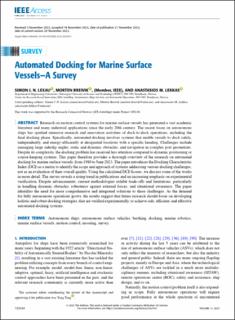| dc.contributor.author | Lexau, Simon Julian Nagelsaker | |
| dc.contributor.author | Breivik, Morten | |
| dc.contributor.author | Lekkas, Anastasios | |
| dc.date.accessioned | 2024-01-19T08:58:28Z | |
| dc.date.available | 2024-01-19T08:58:28Z | |
| dc.date.created | 2023-11-22T13:17:43Z | |
| dc.date.issued | 2023 | |
| dc.identifier.citation | IEEE Access. 2023, 11 132324-132367. | en_US |
| dc.identifier.issn | 2169-3536 | |
| dc.identifier.uri | https://hdl.handle.net/11250/3112698 | |
| dc.description.abstract | Research on motion control systems for marine surface vessels has generated a vast academic literature and many industrial applications since the early 20th century. The recent focus on autonomous ships has sparked intensive research and innovation activities of dock-to-dock operations, including the final docking phase. Specifically, automated docking involves systems that enable vessels to dock safely, independently, and energy-efficiently at designated locations with a specific heading. Challenges include managing large sideslip angles, static and dynamic obstacles, and navigation in complex port geometries. Despite its complexity, the docking problem has received less attention compared to dynamic positioning or course-keeping systems. This paper therefore provides a thorough overview of the research on automated docking for marine surface vessels, from 1980 to June 2023. The paper introduces the Docking Characteristic Index (DCI) as a metric to identify the scope and approach of systems addressing various docking challenges, not as an evaluation of their overall quality. Using the calculated DCI-Scores, we discuss some of the works in more detail. The survey reveals a rising trend in publications and an increasing emphasis on experimental verification. Despite advancements, current methodologies exhibit trade-offs and limitations, particularly in handling dynamic obstacles, robustness against external forces, and situational awareness. The paper identifies the need for more comprehensive and integrated solutions to these challenges. As the demand for fully autonomous operations grows, the results suggest that future research should focus on developing holistic and robust docking strategies, that are verified experimentally, to achieve safe, efficient, and effective automated docking systems. | en_US |
| dc.description.abstract | Automated Docking for Marine Surface Vessels - A Survey | en_US |
| dc.language.iso | eng | en_US |
| dc.publisher | IEEE | en_US |
| dc.rights | Navngivelse 4.0 Internasjonal | * |
| dc.rights.uri | http://creativecommons.org/licenses/by/4.0/deed.no | * |
| dc.title | Automated Docking for Marine Surface Vessels - A Survey | en_US |
| dc.title.alternative | Automated Docking for Marine Surface Vessels - A Survey | en_US |
| dc.type | Peer reviewed | en_US |
| dc.type | Journal article | en_US |
| dc.description.version | publishedVersion | en_US |
| dc.source.pagenumber | 132324-132367 | en_US |
| dc.source.volume | 11 | en_US |
| dc.source.journal | IEEE Access | en_US |
| dc.identifier.doi | 10.1109/ACCESS.2023.3335912 | |
| dc.identifier.cristin | 2200275 | |
| dc.relation.project | Norges forskningsråd: 309230 | en_US |
| cristin.ispublished | true | |
| cristin.fulltext | original | |
| cristin.qualitycode | 1 | |

